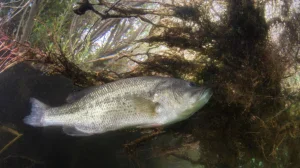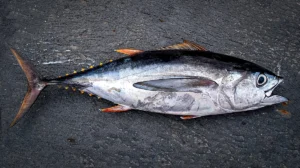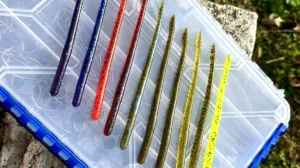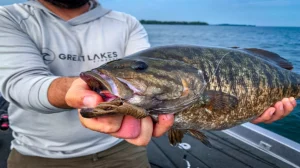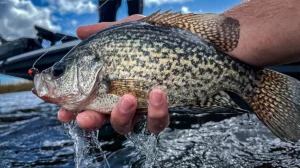It can be difficult to get motivated for bass fishing this time of the year. The bass are slowly but surely becoming exceedingly conscious of the upcoming winter weather and their metabolic rates are screeching to a halt. Compound this ever-increasing inactivity with bone-chilling conditions and it’s pretty darn tempting to stay home and catch up on our honey do lists.
’Tis the season. Welcome to wintertime fishing.
According to Elite Series pro Timmy Horton, however, there’s a ray of hope — an elixir, of sorts — for our winter bass fishing blues. If your timing is just right, you can experience some of the most incredible action of the year by targeting warm runoffs.
To unleash this special pattern’s true potential, he believes it’s important to understand several key elements that will drastically shorten your learning curve.
- Know what makes it special
- Two very different types of runoffs
- Small windows
- Lure selection
Why runoffs and why now?
They’re just not biting.
It’s one of the biggest clichès in our sport and it’s also one of the most prominent excuses for a poor outing on the water. But as both the air and water temperatures drop, this old saying might actually hold some validity.
“I believe there’s always a bass somewhere in the lake that’s ready to eat,” Horton said. “But throughout the colder months, their feeding activity takes place in very short spurts because their metabolism becomes incredibly sluggish. This is one of the reasons they become so difficult to catch; you have to be in the right place at exactly the right time.”
Runoffs, however, seem to level the proverbial playing field by introducing two variables into the equation. They can provide both warm water and enormous concentrations of baitfish on which the bass can feed.
“If the water is below 60 degrees and a warm rain comes through the area, runoffs can be incredibly productive,” Horton said. “The precipitation is often 2 to 3 degrees warmer than the rest of the water which sends the bass into a major feeding mode. Not to mention, the shad flock to these runoffs to gorge on the microorganisms and phytoplankton that are washing into the water.”
In addition to providing warmer temperatures and a smorgasbord of easily available forage, these runoffs often leave behind a distinct stain to the water. Because stained water is much denser than clear water, it will conduct heat faster and remain warmer for days after any rainfall.
“The bass are actively seeking warmer water and when they sense it coming from these runoffs, they’ll get absolutely stacked. The shad do the same thing as well, which creates a perfect storm.”
Understand the two different types of runoffs
Contrary to popular belief, not every runoff is the same. Horton places them into two distinct categories and approaches each one very differently.
“Some may confuse these areas with the precipitation runoff that’s commonly found in the backs of major feeder creeks,” Horton said. “But that type of runoff can actually hurt the fishing this time of year because it can introduce entirely too much mud into the creek, causing both the bass and bait to disappear almost overnight. The runoff pattern I’m describing is much more of a short pocket and cove-oriented deal.”
- Industrial runoff – Runoff from industrial areas, such as manufacturing facilities, often remains consistent throughout the entire year. As a result, the bass become accustomed to it and tend to position much tighter to the influx of water. They’ve learned where the action is, so there’s no point in meandering elsewhere. So when Horton targets these areas, he’ll concentrate his efforts within 10 to 15 yards of the water flow.
- Natural runoff – Whenever new water is introduced into a fishery by way of topographical features, such as mountains and valleys, Horton has noticed a difference in the bass behavior. Instead of positioning tightly to the point of entry, they’ll actually scatter throughout the surrounding area. He’ll still begin his dissection close to the water flow but will work away from it until he stops getting bites. As a general rule, Horton believes the first 20 to 30 yards to be the most productive.
Small windows of opportunity
For some of you, all this talk of big bass might have you chomping at the bit to go try this coldwater technique. But don’t get carried away yet. In order for this to work, both your personal schedule and the weather has to line up almost perfectly.
“This pattern gives you a very small window of opportunity,” Horton said. “But if you watch the weather and get out there at the right time, you won’t believe how crazy the fishing will be. You can literally catch zero bass the day before and hammer a 20-pound limit the very next day.”
So what’s the deal with the weather? When can we expect to jack on ‘em?
- Warm fronts – I always feel obligated to point out that the word warm is a relative term. But regardless of your location, this runoff pattern can take place anytime after a warm rain event. As long as the precipitation is a few degrees warmer than the current water temperature, there’s a solid chance of getting on a great bite. For example, if the water in your favorite lake is currently 45 degrees, make plans to fish runoffs the next time a 50-degree rain hits your area.
- It lasts for a few days – It doesn’t have to be nasty and wet outside to experience this special fishing pattern. If you’d rather stay dry, just make sure to target these runoffs within 4 or 5 days of the most recent rainfall. The fresh water will lasts for several days, so there’s no need to fish in inclement weather.
- It doesn’t take much – If you get a rare 75-degree rain or something similar, fishing runoffs will be absolutely unreal. But an extreme warm front isn’t necessary. Horton has caught countless big bass by targeting runoffs just a degree or two warmer than the rest of the lake, so don’t overthink it. A small increase in water temperature is all it takes.
Find ’em quickly: Use satellite imaging such as Google Earth to find nearby mountain valleys, farm ponds or even wildlife refuges. These are all prime areas to find warm runoff in the colder months.
Productive lures to consider
A boat full of fishing equipment isn’t required for this pattern. To be quite honest, there will be days where you can catch ‘em on just about anything that remotely resembles a baitfish. But day-in and day-out, Horton enjoys the most consistent success on three primary types of lures: a jerkbait, spinnerbait and lipless crankbait.
- Jerkbait – “My number one choice is almost always going to be a hard jerkbait, such as an Azuma Bray Z,” Horton said. “A jerkbait will temporarily spook big balls of shad, which gives the bass an excellent look at your offering. It’s important to use a suspending model because even though we’re searching for warmer water, it’s still relatively cold compared to other times of the year.”
- Spinnerbait – When he finds a runoff in fairly stained water, Horton relies heavily on a 1/2-ounce white and chartreuse-colored spinnerbait, such as a Swampers Target Willow. He makes long casts and slow-rolls it through the area. The added flash and vibration of the blades helps the bass locate the lure and drastically reduces short-strikes.
- Lipless crankbait – “You’ll find a lot of pipes that introduce warmer water near big flats,” Horton said. “The Azuma Shaker Z allows me to cover a lot of water which is extremely important. These pipes will often create a 10 to 15-acre area of warmer water, so you have to use a lure you can fish efficiently.”
If the cold weather sweeping across the nation is making you a bit stir-crazy, grab a couple of rods and search for some nearby runoffs. If you pay close attention to the weather, you’re likely to have a few days of fishing you’ll never forget.



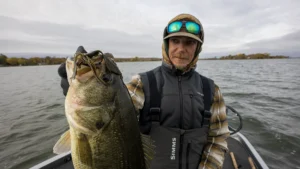


![[VIDEO] McClelland’s Top 7 Winter Bass Baits Explained](https://www.wired2fish.com/wp-content/uploads/2024/12/winter-bass-fishing-lures-300x169.webp)
